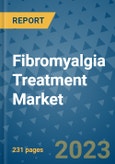Market Insights
Despite the absence of a definitive cure, the fibromyalgia treatment Analysis is evolving, with pharmaceutical and non-pharmaceutical interventions offering partial relief from symptoms. Pharmaceutical treatments such as anticonvulsants, antidepressants, and analgesics continue to dominate the market. Simultaneously, non-pharmaceutical approaches-like cognitive behavioral therapy (CBT), physical therapy, and alternative therapies-are increasingly being integrated into multimodal treatment plans.The burden of fibromyalgia is significant, affecting approximately 2-4% of the global population, with higher prevalence in women. The chronic and idiopathic nature of the syndrome often results in reduced quality of life and high healthcare utilization, prompting sustained demand for both approved and off-label therapeutic approaches.
Key Market Drivers
The primary factors propelling market growth include increasing research and development investments aimed at identifying novel therapeutic targets, expanding clinical trials for emerging drug candidates, and growing awareness of fibromyalgia among healthcare providers and patients. The exploration of combination therapy and repositioning of existing drugs for off-label use has further widened treatment possibilities.Moreover, enhanced understanding of the pathophysiology-particularly the role of central and peripheral nervous system mechanisms in pain perception-has driven innovation in the development of targeted therapies. Companies are also investing in patient-tailored treatments that focus on managing coexisting conditions such as depression, chronic fatigue syndrome, irritable bowel syndrome, and anxiety.
Business Opportunity
One of the most promising opportunities lies in the development of combination therapies and re-evaluation of existing medications for fibromyalgia management. Although current therapies only moderately relieve symptoms in a subset of patients, there is scope for improvement through interdisciplinary research and collaborative clinical programs. The rise of telehealth and digital therapeutics also offers new pathways to deliver cognitive behavioral therapy and personalized care remotely, especially in underserved areas.Furthermore, as regulatory bodies across different regions streamline drug approval processes and prioritize research funding, pharmaceutical companies have greater incentives to develop targeted fibromyalgia therapies.
Regional Analysis
North America is expected to maintain its dominant position in the fibromyalgia treatment market, driven by the high prevalence of fibromyalgia, increased healthcare spending, and strong presence of leading pharmaceutical manufacturers. The availability of generic versions of key drugs and active pipelines from companies such as Aptinyx Inc. and Prismic Pharmaceuticals continue to support market momentum in the region.Europe is anticipated to witness moderate growth due to growing awareness and rising healthcare expenditure, particularly in Germany where short-term use of drugs like pregabalin and duloxetine is recommended in national guidelines despite lack of formal approvals.
Meanwhile, the Asia Pacific region is poised for the fastest growth rate, attributed to the increasing burden of rheumatic diseases, expanding elderly population, and greater efforts to improve disease awareness. In China, where fibromyalgia commonly coexists with rheumatoid arthritis and other musculoskeletal conditions, the market is expanding rapidly.
Key Players
Prominent players operating in the fibromyalgia treatment market include:
- Pfizer, Inc.
- Eli Lilly and Company
- AbbVie, Inc.
- Teva Pharmaceutical Industries Ltd.
- Sanofi
- Johnson & Johnson Services, Inc.
- GlaxoSmithKline plc
- TONIX Pharmaceuticals Holdings Corp
- Virios Therapeutics, Inc.
- Aptinyx Inc.
- FSD Pharma
- Bayer AG
Market Challenges
The growth of the market may be restrained by several factors, including the limited number of approved drugs, variable treatment efficacy, high cost of branded therapies, and lack of reimbursement for newly introduced medications. Additionally, inconsistent adherence to prescribed treatment regimens and the chronic nature of fibromyalgia further complicate disease management and treatment outcomes.Market Segmentation
By Drug Class:
- Antidepressants (Venlafaxine, Duloxetine HCl, Milnacipran HCl, Others)
- Anticonvulsants (Pregabalin, Gabapentin, Others)
- Muscle Relaxants
- Analgesics
By Distribution Channel:
- Hospital Pharmacies
- Drug Stores
- Retail Pharmacies
- Online Pharmacies
By Region:
- North America
- Latin America
- Europe
- South Asia
- East Asia
- Oceania
- Middle East & Africa
This product will be delivered within 1-3 business days.
Table of Contents
Companies Mentioned
- FSD Pharma
- Pfizer, Inc.
- Eli Lilly and Company
- AbbVie, Inc.
- Teva Pharmaceutical Industries Ltd.
- Johnson & Johnson Services, Inc
- Sanofi
- GlaxoSmithKline plc.
- Bayer AG
- TONIX Pharmaceuticals Holdings Corp
- Virios Therapeutics, Inc.
- Aptinyx Inc.








